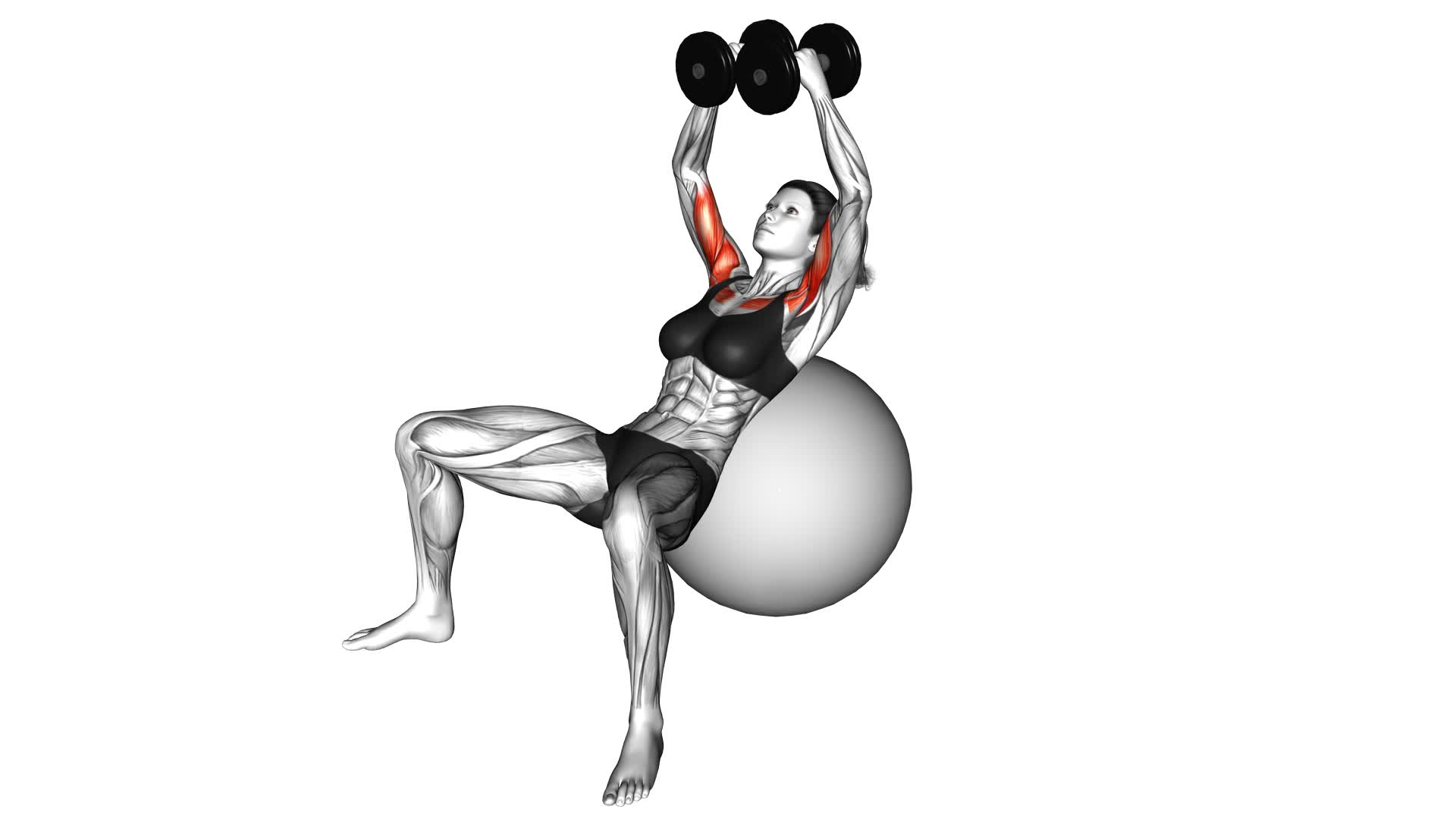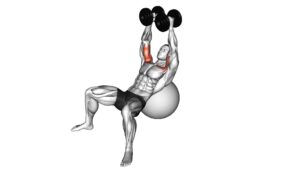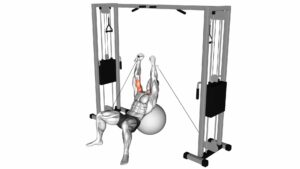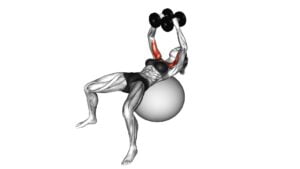Dumbbell Incline Fly on Exercise Ball (female) – Video Exercise Guide & Tips

Want to tone your upper body and strengthen your chest muscles? Look no further than the dumbbell incline fly on an exercise ball. This effective exercise targets your chest, shoulders, and arms while also engaging your core for added stability.
Watch This Exercise Video
In this video exercise guide, you'll learn the proper form and technique, tips for choosing the right weight and equipment, modifications for different fitness levels, and common mistakes to avoid.
Get ready to take your workout to new heights with the dumbbell incline fly!
Key Takeaways
- The Dumbbell Incline Fly on an exercise ball targets chest muscles effectively and engages the core for added stability.
- Proper form and technique include lying on the exercise ball with feet planted, holding dumbbells with palms facing each other, and lowering the dumbbells out to the sides in a wide arc motion.
- Common mistakes to avoid include using too heavy of a weight, jerking or using momentum, compromising form and increasing the risk of injury, and locking elbows or shrugging shoulders.
- When choosing the right weight and equipment, consider fitness level and goals, start with lighter weights for beginners, gradually increase weight as strength improves, choose an exercise ball that provides stability and support, and ensure the exercise ball is the right size for your height.
Benefits of the Dumbbell Incline Fly on Exercise Ball
You can experience several benefits from incorporating the dumbbell incline fly on an exercise ball into your workout routine. This exercise specifically targets your chest muscles, activating them more effectively than other chest exercises. The incline position on the exercise ball allows for a greater range of motion, engaging your chest muscles throughout the entire movement.
During the dumbbell incline fly on the exercise ball, your chest muscles, including the pectoralis major and pectoralis minor, are activated to a high degree. The incline angle of the exercise ball increases the activation of these muscles compared to traditional flat bench exercises. This increased muscle activation leads to greater strength and muscle development in your chest.
When comparing the effectiveness of the dumbbell incline fly on the exercise ball to other chest exercises, it stands out as one of the best for targeting the chest muscles. The incline angle of the exercise ball places more emphasis on the upper chest, helping to develop a well-rounded chest shape. Additionally, the instability of the exercise ball engages your core muscles, providing an added challenge and strengthening your core stability.
Incorporating the dumbbell incline fly on an exercise ball into your workout routine can help you achieve a stronger and more defined chest. The targeted muscle activation and increased range of motion make this exercise a valuable addition to your chest training regimen.
Proper Form and Technique for the Dumbbell Incline Fly
To perform the Dumbbell Incline Fly with proper form and technique, start by lying on an exercise ball with your feet planted firmly on the ground. Hold a dumbbell in each hand, with your palms facing each other. Extend your arms straight out in front of you, keeping a slight bend in your elbows. Engage your core and maintain a neutral spine throughout the exercise.
As you inhale, slowly lower the dumbbells out to the sides in a wide arc motion, keeping a slight bend in your elbows. Lower until your upper arms are parallel to the ground, or until you feel a stretch in your chest muscles. Exhale as you bring the dumbbells back up to the starting position, squeezing your chest muscles at the top of the movement.
To ensure proper form and technique, it's important to avoid common errors such as using too heavy of a weight, which can compromise your form and increase the risk of injury. It's also important to avoid jerking or using momentum to lift the dumbbells, as this takes away from the effectiveness of the exercise.
If you're looking for alternative exercises to the Dumbbell Incline Fly, you can try the Cable Chest Fly or the Pec Deck machine. These exercises target the same muscles and can be great alternatives if you don't have access to dumbbells or an exercise ball.
Remember to always consult with a fitness professional before attempting any new exercises, especially if you have any underlying health conditions or injuries.
Choosing the Right Weight and Equipment for the Exercise
When selecting the appropriate weight and equipment for the dumbbell incline fly exercise, it's crucial to consider both your fitness level and the specific goals you want to achieve. Choosing the right weights and dumbbells is essential to ensure that you challenge your muscles without risking injury. As a general guideline, beginners should start with lighter weights and gradually increase the resistance as their strength improves. On the other hand, more advanced individuals may opt for heavier weights to maximize their muscle growth and strength gains.
In addition to selecting the appropriate weights, it's important to choose the right exercise ball for the exercise. The exercise ball should be firm enough to provide stability and support during the exercise. It should also be the right size for your height. As a general rule, when sitting on the exercise ball, your hips should be slightly higher than your knees, and your feet should be flat on the floor.
Modifications and Progressions for Different Fitness Levels
To modify and progress the dumbbell incline fly exercise for different fitness levels, consider implementing variations in weight, range of motion, and difficulty. For beginners or those who are new to the exercise, it's recommended to start with lighter weights to ensure proper form and technique. This will allow you to focus on building strength and stability in the targeted muscles. As you become more comfortable and confident with the exercise, you can gradually increase the weight to continue challenging yourself.
Another modification for beginners is to reduce the range of motion. Instead of lowering the dumbbells all the way down until they touch your chest, you can start by only lowering them halfway. This will help you gradually increase your range of motion over time.
For advanced variations, you can increase the weight of the dumbbells to further challenge your muscles. Additionally, you can try performing the exercise on a higher incline bench or using an exercise ball instead of a bench. These variations will engage more stabilizer muscles and increase the difficulty of the exercise.
Common Mistakes to Avoid During the Dumbbell Incline Fly
One common mistake to avoid during the dumbbell incline fly is using improper form. To ensure effective execution of this exercise, it's important to maintain the correct posture throughout.
Firstly, make sure to keep your back flat against the exercise ball and your feet firmly planted on the ground. This will help stabilize your body and prevent any unnecessary strain on your lower back.
Secondly, keep your elbows slightly bent and your shoulders relaxed. Avoid locking your elbows or shrugging your shoulders, as this can lead to muscle tension and potential injury.
Another common mistake is using weights that are too heavy. It's essential to choose a weight that allows you to maintain proper form and complete the exercise with control. Using weights that are too heavy can compromise your form and put excessive strain on your muscles and joints.
Lastly, avoid swinging your arms or using momentum to lift the weights. This not only reduces the effectiveness of the exercise but also increases the risk of injury. Instead, focus on controlled and smooth movements, maintaining tension in your chest muscles throughout the entire range of motion.
Tips for Incorporating the Dumbbell Incline Fly Into Your Workout Routine
Are you unsure of how to incorporate the dumbbell incline fly into your workout routine? Don't worry, we've got you covered. Here are some tips to help you effectively include this exercise in your fitness regimen:
- Start with proper warm-up: Prior to performing the dumbbell incline fly, it's essential to warm up your upper body muscles. This can be done through light cardio exercises or dynamic stretches.
- Choose the right weight: Select a pair of dumbbells that challenge you without compromising your form. It's better to start with lighter weights and gradually increase the load as you become comfortable with the exercise.
- Focus on form: Maintain proper form throughout the exercise to target the intended muscles effectively. Keep your back flat against the incline bench, engage your core, and control the movement as you lower the dumbbells.
- Experiment with variations: There are various ways to modify the incline fly to add variety and target different muscle groups. For instance, you can try performing the exercise on a stability ball or using a wide grip to emphasize the chest muscles.
Incorporating dumbbell exercises like the incline fly into your workout routine can help you build strength and improve muscle tone. Remember to consult with a fitness professional if you're unsure about proper technique or have any concerns.
Frequently Asked Questions
Can I Perform the Dumbbell Incline Fly on a Regular Bench Instead of an Exercise Ball?
Yes, you can perform the dumbbell incline fly on a regular bench instead of an exercise ball. While the exercise ball offers benefits like improved stability and core engagement, using a regular bench is a suitable alternative.
However, keep in mind that you may not experience the same level of challenge for your stabilizer muscles. It's important to maintain proper form and control throughout the exercise to maximize its effectiveness.
How Many Sets and Reps Should I Do for the Dumbbell Incline Fly?
To properly perform the dumbbell incline fly, it's important to know how many sets and reps to do. For optimal results, aim for 3-4 sets of 8-12 reps. This will help target your chest muscles and promote muscle growth.
Remember to choose a weight that challenges you but still allows you to maintain proper form throughout the exercise.
Additionally, there are variations of the dumbbell incline fly that you can try to switch up your routine and target different areas of your chest.
Is the Dumbbell Incline Fly Suitable for Beginners?
The dumbbell incline fly can be a suitable exercise for beginners. It helps to strengthen your chest muscles and improve upper body stability.
When performing this exercise, it's important to start with light weights and focus on proper form. Avoid using too much weight and swinging your arms, as this can lead to strain or injury.
Always maintain control and engage your chest muscles throughout the movement to maximize the benefits and avoid common mistakes.
Can I Perform the Dumbbell Incline Fly Without a Spotter?
When performing the dumbbell incline fly without a spotter, it's important to focus on proper form and technique. Make sure to choose a weight that you can handle safely.
Keep your core engaged and maintain a stable position on the exercise ball. Keep your arms slightly bent and lower the dumbbells down to the sides, feeling a stretch in your chest muscles.
Remember to start with lighter weights and gradually increase as you become more comfortable and confident.
How Often Should I Incorporate the Dumbbell Incline Fly Into My Workout Routine?
To properly perform the dumbbell incline fly, start by lying on an incline bench with a dumbbell in each hand. Extend your arms out to the sides, keeping a slight bend in your elbows.
Slowly lower the weights towards the floor, feeling a stretch in your chest muscles. Then, raise the dumbbells back up to the starting position.
Incorporating this exercise into your workout routine can help strengthen your chest muscles and improve upper body strength.
Conclusion
Incorporating the dumbbell incline fly on an exercise ball into your workout routine can provide numerous benefits, such as targeting the chest, shoulders, and arms. By maintaining proper form and technique, choosing the right weight and equipment, and avoiding common mistakes, you can maximize the effectiveness of this exercise.
Whether you're a beginner or a more experienced fitness enthusiast, modifications and progressions can be made to suit your fitness level.
So why not give the dumbbell incline fly a try and take your upper body workout to the next level?

Author
Years ago, the spark of my life’s passion ignited in my mind the moment I stepped into the local gym for the first time. The inaugural bead of perspiration, the initial endeavor, the very first surge of endorphins, and a sense of pride that washed over me post-workout marked the beginning of my deep-seated interest in strength sports, fitness, and sports nutrition. This very curiosity blossomed rapidly into a profound fascination, propelling me to earn a Master’s degree in Physical Education from the Academy of Physical Education in Krakow, followed by a Sports Manager diploma from the Jagiellonian University. My journey of growth led me to gain more specialized qualifications, such as being a certified personal trainer with a focus on sports dietetics, a lifeguard, and an instructor for wellness and corrective gymnastics. Theoretical knowledge paired seamlessly with practical experience, reinforcing my belief that the transformation of individuals under my guidance was also a reflection of my personal growth. This belief holds true even today. Each day, I strive to push the boundaries and explore new realms. These realms gently elevate me to greater heights. The unique combination of passion for my field and the continuous quest for growth fuels my drive to break new ground.



